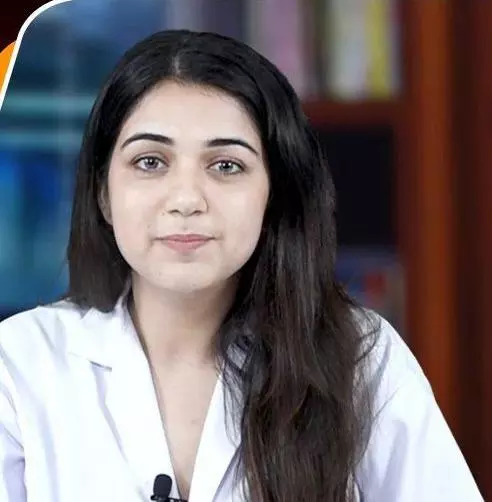- Home
- Medical news & Guidelines
- Anesthesiology
- Cardiology and CTVS
- Critical Care
- Dentistry
- Dermatology
- Diabetes and Endocrinology
- ENT
- Gastroenterology
- Medicine
- Nephrology
- Neurology
- Obstretics-Gynaecology
- Oncology
- Ophthalmology
- Orthopaedics
- Pediatrics-Neonatology
- Psychiatry
- Pulmonology
- Radiology
- Surgery
- Urology
- Laboratory Medicine
- Diet
- Nursing
- Paramedical
- Physiotherapy
- Health news
- Fact Check
- Bone Health Fact Check
- Brain Health Fact Check
- Cancer Related Fact Check
- Child Care Fact Check
- Dental and oral health fact check
- Diabetes and metabolic health fact check
- Diet and Nutrition Fact Check
- Eye and ENT Care Fact Check
- Fitness fact check
- Gut health fact check
- Heart health fact check
- Kidney health fact check
- Medical education fact check
- Men's health fact check
- Respiratory fact check
- Skin and hair care fact check
- Vaccine and Immunization fact check
- Women's health fact check
- AYUSH
- State News
- Andaman and Nicobar Islands
- Andhra Pradesh
- Arunachal Pradesh
- Assam
- Bihar
- Chandigarh
- Chattisgarh
- Dadra and Nagar Haveli
- Daman and Diu
- Delhi
- Goa
- Gujarat
- Haryana
- Himachal Pradesh
- Jammu & Kashmir
- Jharkhand
- Karnataka
- Kerala
- Ladakh
- Lakshadweep
- Madhya Pradesh
- Maharashtra
- Manipur
- Meghalaya
- Mizoram
- Nagaland
- Odisha
- Puducherry
- Punjab
- Rajasthan
- Sikkim
- Tamil Nadu
- Telangana
- Tripura
- Uttar Pradesh
- Uttrakhand
- West Bengal
- Medical Education
- Industry
Brain stroke cases increasing in younger population - Video
Overview
Brain stroke has long been considered a disease of the elderly, but recent data suggests it is now commonly occurring in young population in India as well. The occurrence of stroke in young adults is particularly concerning as these patients in the prime of their life are often affected by physical disability, depression, cognitive impairment, and loss of productivity, all of which have serious personal, social, and economic implications. This was said by doctors of Amrita Hospital, Faridabad, (Dr. Sanjay Pandey, Dr. Amit Kumar Agarwal and Dr. Deepak Yadav) on occasion of the World Stroke Day 2022.
Talking about the rising incidence of stroke in India in lower age groups, Dr. Sanjay Pandey, Head, Dept. of Neurology, Amrita Hospital, Faridabad, said: "Stroke is the second most common cause of death and the third-leading cause of death and disability combined in the world. So, it is a matter of serious concern that it is no longer a disease of the elderly in our country. A hospital-based study from India has shown that the proportion of strokes in young people now ranges from 15-30%. In another population-based study in the country, 8.8% of total stroke patients were found to belong to the younger age group."
The traditional risk factors of brain stroke include hypertension, diabetes mellitus, and hyperlipidemia (a condition in which blood has too many lipids or fats, like cholesterol and triglycerides). However, there are several other risk factors that are unique to the young Indian population, according to the doctor.
Hyperhomocysteinaemia, a medical condition characterized by an abnormally high level of homocysteine in the blood, is often found in people with vitamin b12 deficiency. This is one of the risk factors for stroke. Dr. Sanjay Pandey said: "Considering the large vegetarian population in India with inadequate intake of vitamin b12, this risk factor for stroke is quite significant. Many studies have published data suggesting that vitamin b12 therapy helps lower homocysteine levels in an individual. This provides a strong case for stroke prevention through food fortification with folic acid and vitamin b12 in vegetarian population."
He added that cardioembolic stroke is the most common cause of stroke in young people in India. In this, a blood clot arises in the heart, travels to the brain and blocks an artery, leading to a stroke. This often happens due to heart conditions such as rheumatic heart disease. Two rare disorders of the blood vessels, Moya Moya disease and Takayasu's arteritis, are also more frequently seen in Asian countries, including India, and can cause a stroke. Infectious disorders like tuberculosis and syphilis may also lead to a stroke. These are still prevalent in many south-east Asian countries like India.
Dr. Sanjay Pandey said that cerebral venous thrombosis (CVT), a rare type of stroke, is also more common in India. "In a study, CVT was found to be 12 times more common in India than in the Western population! In a hospital-based study from India, CVT was reported in 16.3% of total strokes in young, which is higher than other reported studies all over the world. Also, the incidence of CVT is higher in females during pregnancy or the postpartum period. This gender bias is more important for the Indian population where access to healthcare for females, especially those who are pregnant, is poor, especially in rural areas," he added.
Stroke may also occur in children. "The risk factors for pediatric stroke in India are different from developed countries. Lack of adequate oxygen before or after birth (hypoxia), along with infection-related disorders affecting arteries in the brain, are some of the leading causes of stroke in Indian children. Sadly, two-thirds of children surviving stroke go on to develop a neurological disability," said Dr. Sanjay Pandey.
There is an urgent need to do more population-based studies regarding stroke in India to know the exact prevalence, etiology, and incidence rates, he added.



